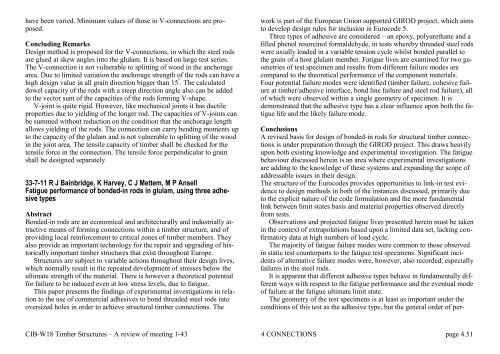Download pdf - CIB-W18
Download pdf - CIB-W18
Download pdf - CIB-W18
- TAGS
- download
- cib-w18.com
You also want an ePaper? Increase the reach of your titles
YUMPU automatically turns print PDFs into web optimized ePapers that Google loves.
have been varied. Minimum values of those in V-connections are proposed.<br />
Concluding Remarks<br />
Design method is proposed for the V-connections, in which the steel rods<br />
are glued at skew angles into the glulam. It is based on large test series.<br />
The V-connection is not vulnerable to splitting of wood in the anchorage<br />
area. Due to limited variation the anchorage strength of the rods can have a<br />
high design value in all grain direction bigger than 15 º . The calculated<br />
dowel capacity of the rods with a steep direction angle also can be added<br />
to the vector sum of the capacities of the rods forming V-shape.<br />
V-joint is quite rigid. However, like mechanical joints it has ductile<br />
properties due to yielding of the longer rod. The capacities of V-joints can<br />
be summed without reduction on the condition that the anchorage length<br />
allows yielding of the rods. The connection can carry bending moments up<br />
to the capacity of the glulam and is not vulnerable to splitting of the wood<br />
in the joint area. The tensile capacity of timber shall be checked for the<br />
tensile force in the connection. The tensile force perpendicular to grain<br />
shall be designed separately<br />
33-7-11 R J Bainbridge, K Harvey, C J Mettem, M P Ansell<br />
Fatigue performance of bonded-in rods in glulam, using three adhesive<br />
types<br />
Abstract<br />
Bonded-in rods are an economical and architecturally and industrially attractive<br />
means of forming connections within a timber structure, and of<br />
providing local reinforcement to critical zones of timber members. They<br />
also provide an important technology for the repair and upgrading of historically<br />
important timber structures that exist throughout Europe.<br />
Structures are subject to variable actions throughout their design lives,<br />
which normally result in the repeated development of stresses below the<br />
ultimate strength of the material. There is however a theoretical potential<br />
for failure to be induced even at low stress levels, due to fatigue.<br />
This paper presents the findings of experimental investigations in relation<br />
to the use of commercial adhesives to bond threaded steel rods into<br />
oversized holes in order to achieve structural timber connections. The<br />
work is part of the European Union supported GIROD project, which aims<br />
to develop design rules for inclusion in Eurocode 5.<br />
Three types of adhesive are considered – an epoxy, polyurethane and a<br />
filled phenol resorcinol formaldehyde, in tests whereby threaded steel rods<br />
were axially loaded in a variable tension cycle whilst bonded parallel to<br />
the grain of a host glulam member. Fatigue lives are examined for two geometries<br />
of test specimen and results from different failure modes are<br />
compared to the theoretical performance of the component materials.<br />
Four potential failure modes were identified (timber failure, cohesive failure<br />
at timber/adhesive interface, bond line failure and steel rod failure), all<br />
of which were observed within a single geometry of specimen. It is<br />
demonstrated that the adhesive type has a clear influence upon both the fatigue<br />
life and the likely failure mode.<br />
Conclusions<br />
A revised basis for design of bonded-in rods for structural timber connections<br />
is under preparation through the GIROD project. This draws heavily<br />
upon both existing knowledge and experimental investigation. The fatigue<br />
behaviour discussed herein is an area where experimental investigations<br />
are adding to the knowledge of these systems and expanding the scope of<br />
addressable issues in their design.<br />
The structure of the Eurocodes provides opportunities to link-in test evidence<br />
to design methods in both of the instances discussed, primarily due<br />
to the explicit nature of the code formulation and the more fundamental<br />
link between limit states basis and material properties observed directly<br />
from tests.<br />
Observations and projected fatigue lives presented herein must be taken<br />
in the context of extrapolations based upon a limited data set, lacking confirmatory<br />
data at high numbers of load cycle.<br />
The majority of fatigue failure modes were common to those observed<br />
in static test counterparts to the fatigue test specimens. Significant incidents<br />
of alternative failure modes were, however, also recorded, especially<br />
failures in the steel rods.<br />
It is apparent that different adhesive types behave in fundamentally different<br />
ways with respect to the fatigue performance and the eventual mode<br />
of failure at the fatigue ultimate limit state.<br />
The geometry of the test specimens is at least as important under the<br />
conditions of this test as the adhesive type, but the general order of per-<br />
<strong>CIB</strong>-<strong>W18</strong> Timber Structures – A review of meeting 1-43 4 CONNECTIONS page 4.51














